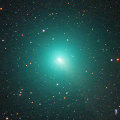
|
It approached to the earth down to 0.12 A.U. and brightened up to 4.6 mag in October (Oct. 18, Juan Jose Gonzalez). It was very large, double of the full moon, and very bright, visible with naked eyes. Now it is fading, but still bright as 7.4 mag (Dec. 11, Juan Jose Gonzalez). After this, it keeps observable for a long time until 2011 June when it fades down to 17 mag.
Date(TT) R.A. (2000) Decl. Delta r Elong. m1 Best Time(A, h)
Dec. 11 7 35.06 -17 47.6 0.340 1.216 126 7.3 2:18 (180, 73)
Dec. 18 7 30.06 -18 14.0 0.379 1.264 130 7.7 1:45 (180, 73)
|
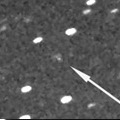
|
The condition in this apparition is bad. It keeps unobservable for a while. In the Southern Hemisphere, it will appear in the morning sky at 12.5 mag in February, then it keeps observable while fading gradually. In the Northern Hemisphere, it is not observable until when it fades down to 15 mag.
Date(TT) R.A. (2000) Decl. Delta r Elong. m1 Best Time(A, h)
Dec. 11 15 51.24 -17 36.8 2.439 1.545 19 12.7 2:53 (299, -9)
Dec. 18 16 13.43 -19 8.8 2.409 1.532 20 12.5 2:54 (299, -7)
|
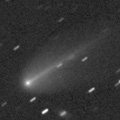
|
Bright new comet discovered visually by Kaoru Ikeya and Shigeki Murakami. Now it is 13.4 mag (Dec. 8, Shigeki Murakami). Its envelope similar to 17P/Holmes is getting diffuse rapidly. In the Northern Hemisphere, it keeps observable for a long time after this in the morning low sky. It locates very low in the Southern Hemisphere, but it will be getting higher gradually.
Date(TT) R.A. (2000) Decl. Delta r Elong. m1 Best Time(A, h)
Dec. 11 14 7.94 -13 47.2 2.231 1.671 44 12.6 2:53 (281, 8)
Dec. 18 14 24.84 -15 43.3 2.208 1.694 46 13.2 2:54 (281, 12)
|

|
Already very bright as 11.5 mag (Nov. 24, Juan Jose Gonzalez). It is expected to keep so bright as 6-8 mag for a long time from 2011 to 2012, and to be observable in good condition in the Northern Hemisphere. In 2010, it is observable in good condition in the Southern Hemisphere while brightening slowly. It locates low in the Northern Hemisphere, but it keeps observable until the end of 2010.
Date(TT) R.A. (2000) Decl. Delta r Elong. m1 Best Time(A, h)
Dec. 11 21 55.12 -30 37.3 5.053 4.687 62 13.4 20:52 ( 75, 37)
Dec. 18 21 55.81 -29 39.2 5.092 4.622 56 13.3 20:58 ( 73, 30)
|
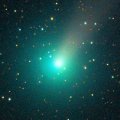
|
It brightened up to 7.9 mag in April and May (May 5, Juan Jose Gonzalez). Now it is fading. The central part is so faint as 15-16 mag. However, extremely faint large coma extends, and the total brightness is still bright as 12.5 mag (Dec. 5, Uwe Pilz). It keeps observable for a long time until when it fades out in the Northern Hemisphere. It is not observable in the Southern Hemisphere.
Date(TT) R.A. (2000) Decl. Delta r Elong. m1 Best Time(A, h)
Dec. 11 5 25.47 46 22.9 2.316 3.243 156 13.8 0:10 (180, 9)
Dec. 18 5 7.20 44 26.7 2.382 3.314 157 14.0 23:18 (180, 11)
|

|
Now it is 13.7 mag (Dec. 8, D. Chestnov and A. Novichonok).
Date(TT) R.A. (2000) Decl. Delta r Elong. m1 Best Time(A, h)
Dec. 11 11 15.44 -0 5.4 6.182 6.241 88 13.9 2:53 (241, 35)
Dec. 18 11 16.60 -0 22.5 6.069 6.242 95 13.9 2:54 (236, 40)
|

|
It has kept bright as 8.5 mag since July until September. Now it is fading, but it is still bright as 12.5 mag (Dec. 4, Katsumi Yoshimoto). It will be visible visually until December.
Date(TT) R.A. (2000) Decl. Delta r Elong. m1 Best Time(A, h)
Dec. 11 1 16.76 -9 53.0 1.499 2.102 114 13.9 20:52 (150, 62)
Dec. 18 1 21.79 -8 15.9 1.612 2.146 109 14.2 20:58 (140, 57)
|
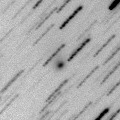
|
Now it is 12.9 mag, much brighter than originally expected and visible visually (Dec. 4, Seiichi Yoshida). In the Northern Hemisphere, it will be observable at 13-14 ag in good condition from autumn to winter. In the Southern Hemisphere, it will be unobservable until 2011 spring.
Date(TT) R.A. (2000) Decl. Delta r Elong. m1 Best Time(A, h)
Dec. 11 20 6.72 47 28.5 2.542 2.575 80 13.9 20:52 (131,-26)
Dec. 18 20 25.61 44 4.6 2.593 2.561 77 13.9 20:58 (127,-27)
|

|
Big asteroid discovered in 1906. It suddenly showed the cometary activity on Dec. 11. Now it is 13.4 mag (Dec. 11, S. Larson), brighter than quiescent phase by 1 mag. The coma extends up to 5 arcmin.
Date(TT) R.A. (2000) Decl. Delta r Elong. m1 Best Time(A, h)
Dec. 11 9 58.04 28 3.5 2.550 3.109 115 14.3 2:53 (206, 22)
Dec. 18 9 59.54 28 43.7 2.457 3.099 122 14.2 2:54 (199, 24)
|
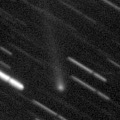
|
Now it is 13.8 mag and visible visually (Nov. 13, Juan Jose Gonzalez). It keeps observable at 14-15 mag in good condition from autumn to next spring.
Date(TT) R.A. (2000) Decl. Delta r Elong. m1 Best Time(A, h)
Dec. 11 6 42.44 0 58.7 2.113 2.998 148 14.4 1:26 (180, 54)
Dec. 18 6 27.01 -1 48.8 2.078 2.986 152 14.4 0:43 (180, 57)
|

|
It reached up to 7.7 mag in 2009 summer (2009 Aug. 13, Chris Wyatt). It is fading now. It will never be observable again in the Northern Hemisphere. It becomes low also in the Southern Hemisphere. Therefore, no observations have been reported since October. But it will be getting higher after January. In the Southern Hemisphere, it keeps observable in good condition until 2011 autumn when it becomes fainter than 18 mag.
Date(TT) R.A. (2000) Decl. Delta r Elong. m1 Best Time(A, h)
Dec. 11 17 43.37 -48 27.7 6.545 5.679 26 14.8 20:52 ( 32, 6)
Dec. 18 17 47.84 -48 48.2 6.599 5.727 25 14.9 20:58 ( 28, 3)
|

|
It brightened up to 11.5 mag in July (July 18, Juan Jose Gonzalez). Now it is 14.9 mag (Nov. 25, A. Novichonok and D. Chestnov). Fading slowly. It is observable in excellent condition in the Southern Hemisphere. It will be getting lower in the evening sky gradually, and will be unobservable in January.
Date(TT) R.A. (2000) Decl. Delta r Elong. m1 Best Time(A, h)
Dec. 11 21 46.80 -23 19.7 3.270 2.953 62 15.0 20:52 ( 83, 32)
Dec. 18 21 56.13 -22 18.3 3.373 2.973 58 15.1 20:58 ( 81, 27)
|
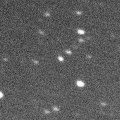
|
Now it is 14.8 mag (June 23, Hidetaka Sato). It keeps bright as 14-15 mag for a long time after this until 2013. It is not observable in the Northern Hemisphere. In the Southern Hemisphere, it locates low now. But it will be getting higher gradually after December. It must be bright, however, no observations have been reported since early July.
Date(TT) R.A. (2000) Decl. Delta r Elong. m1 Best Time(A, h)
Dec. 11 15 32.89 -55 44.8 6.891 6.139 37 15.1 2:53 (326, 18)
Dec. 18 15 39.37 -56 42.9 6.836 6.116 40 15.0 2:54 (325, 21)
|

|
Now it is 15.2 mag (Dec. 7, D. Chestnov and A. Novichonok). It has a long tail by CCD observations. It keeps observable after this while fading gradually.
Date(TT) R.A. (2000) Decl. Delta r Elong. m1 Best Time(A, h)
Dec. 11 12 38.22 -19 17.4 2.423 2.163 63 15.1 2:53 (274, 29)
Dec. 18 12 47.30 -20 38.7 2.393 2.212 67 15.3 2:54 (273, 34)
|

|
Now it is 14.5 mag and visible visually (Sept. 30, Alan Hale). It will be observable at 13-14 mag for a long time from 2011 to 2012. It will be getting lower gradually in the evening sky after this. It will be unobservable in November in the Southern Hemisphere, or in December in the Northern Hemisphere.
Date(TT) R.A. (2000) Decl. Delta r Elong. m1 Best Time(A, h)
Dec. 11 20 9.54 -7 9.7 6.960 6.312 45 15.2 20:52 ( 84, 3)
Dec. 18 20 10.62 -7 15.8 7.015 6.283 39 15.2 20:58 ( 79, -3)
|

|
It passed the perihelion on Nov. 25. In the Northern Hemisphere, it appeared in the evening sky. It keeps observable until February when it becomes fainter than 18 mag. It will not be observable in the Southern Hemisphere.
Date(TT) R.A. (2000) Decl. Delta r Elong. m1 Best Time(A, h)
Dec. 11 19 2.71 -12 9.3 1.098 0.528 28 15.4 20:52 ( 71, -6)
Dec. 18 19 59.43 -7 17.3 1.146 0.689 36 15.9 20:58 ( 78, -5)
|
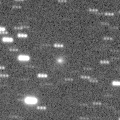
|
Now it is 14.5 mag (Nov. 8, K. Hills), much brighter than originally expected. It keeps 16 mag until 2011 spring. It keeps observable in good condition in the Southern Hemisphere. But in the Northern Hemisphere, it locates very low in 2011 spring only.
Date(TT) R.A. (2000) Decl. Delta r Elong. m1 Best Time(A, h)
Dec. 11 10 34.52 -67 49.5 3.007 2.863 72 15.5 2:53 (339, 51)
Dec. 18 10 9.24 -68 59.3 2.946 2.873 76 15.5 2:54 (346, 54)
|

|
Now it is 15.2 mag (Nov. 27, A. Novichonok and D. Chestnov). It will be fading very slowly after this. In the Northern Hemisphere, it keeps observable for a long time until 2012 spring when it fades down to 17-18 mag. It will not be observable in the Southern Hemisphere.
Date(TT) R.A. (2000) Decl. Delta r Elong. m1 Best Time(A, h)
Dec. 11 19 7.92 31 52.4 4.935 4.549 61 15.5 20:52 (110,-30)
Dec. 18 19 17.98 31 50.5 4.971 4.557 59 15.6 20:58 (108,-34)
|
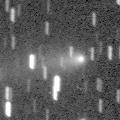
|
Now it is 14.6 mag and visible visually (Dec. 4, Seiichi Yoshida). It is observable at 15 mag in good condition from autumn to winter. It locates somewhat low in the Southern Hemisphere.
Date(TT) R.A. (2000) Decl. Delta r Elong. m1 Best Time(A, h)
Dec. 11 6 51.66 34 55.9 1.257 2.190 154 15.7 1:35 (180, 20)
Dec. 18 6 45.76 36 54.0 1.251 2.204 160 15.7 1:02 (180, 18)
|

|
A small outburst occured and it brightened by 2 mag, up to 16.1 mag, on 2010 Aug. 31 (Bernhard Haeusler). Now it is 15.5 mag (Dec. 4, Ken-ichi Kadota). It will brighten up to 11.5 mag in 2011 autumn. In the Northern Hemisphere, it keeps observable for a long time until 2012 spring. In the Southern Hemisphere, it is not observable until 2011 November.
Date(TT) R.A. (2000) Decl. Delta r Elong. m1 Best Time(A, h)
Dec. 11 16 19.66 20 36.4 4.208 3.585 45 16.2 2:53 (270,-38)
Dec. 18 16 26.65 21 27.6 4.101 3.525 48 16.0 2:54 (266,-34)
|
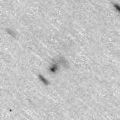
|
Now it is 16.0 mag (Dec. 4, D. Chestnov & A. Novichonok). It will be fading slowly after this. It is not observable at all in the Northern Hemisphere. It is observable in good condition in the Southern Hemisphere, but it will be getting lower gradually after January.
Date(TT) R.A. (2000) Decl. Delta r Elong. m1 Best Time(A, h)
Dec. 11 0 57.89 -72 22.2 2.890 2.815 75 16.3 20:52 ( 9, 52)
Dec. 18 0 36.94 -68 35.9 2.956 2.832 73 16.4 20:58 ( 19, 52)
|
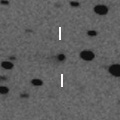
|
Now it is 17.5 mag (Nov. 27, Ken-ichi Kadota). It keeps 17 mag for a long time from 2009 to 2012. It is observable in good condition in the Northern Hemisphere. It locates somewhat low in the Southern Hemisphere.
Date(TT) R.A. (2000) Decl. Delta r Elong. m1 Best Time(A, h)
Dec. 11 1 3.74 16 27.8 7.527 8.091 121 17.0 20:52 (159, 36)
Dec. 18 1 0.41 16 6.6 7.634 8.085 114 17.0 20:58 (149, 33)
|
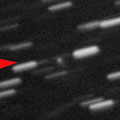
|
Now it is 16.8 mag (Nov. 27, A. Novichonok and D. Chestnov). In the Northern Hemisphere, it keeps observable in good condition until 2011 spring when it brightens up to 16 mag. In the Southern Hemisphere, it keeps locating low.
Date(TT) R.A. (2000) Decl. Delta r Elong. m1 Best Time(A, h)
Dec. 11 5 22.55 37 10.9 1.667 2.632 165 17.1 0:06 (180, 18)
Dec. 18 5 14.73 37 44.8 1.642 2.604 164 17.0 23:26 (180, 17)
|

|
It was observed only during 3 days in 2009 May, then it has been lost. The ephemeris says that it passes the perihelion in 2011 January and it will be observable at 17 mag. But actually, it will not be found.
Date(TT) R.A. (2000) Decl. Delta r Elong. m1 Best Time(A, h)
Dec. 11 8 15.99 -17 25.7 3.332 3.910 119 17.0 2:53 (185, 72)
Dec. 18 8 2.91 -18 7.3 3.245 3.906 126 17.0 2:19 (180, 73)
|

|
Now it is 16.9 mag (Nov. 28, A. Novichonok and D. Chestnov). It is expected to be 15 mag and will be observable in good condition in 2013. It is observable in good condition in the Northern Hemisphere, but not observable in the Southern Hemisphere now.
Date(TT) R.A. (2000) Decl. Delta r Elong. m1 Best Time(A, h)
Dec. 11 2 2.62 60 13.7 7.801 8.474 130 17.2 20:52 (179, -5)
Dec. 18 1 55.38 59 39.0 7.817 8.442 126 17.2 20:58 (174, -5)
|

|
Peculiar asteroid moving along a comet-like retrograde orbit. Now it is 16.9 mag (Nov. 5, Hidetaka Sato). It is observable in excellent condition in the Southern Hemisphere. It locates extremely low in the Northern Hemisphere. It will not be observable in January.
Date(TT) R.A. (2000) Decl. Delta r Elong. m1 Best Time(A, h)
Dec. 11 0 12.49 -41 37.5 1.419 1.665 85 17.3 20:52 ( 66, 65)
Dec. 18 23 46.10 -38 56.2 1.571 1.646 76 17.5 20:58 ( 70, 54)
|

|
Now it is 17.4 mag (Dec. 9, Tzec Maun observatory). It tends to be brightest after the perihelion passage. At the discovery in 1999, it became brightest one year after the perihelion passage. At this time, it became brightest three months after the perihelion passage, then it is fading. It keeps observable in good condition at 18 mag until may.
Date(TT) R.A. (2000) Decl. Delta r Elong. m1 Best Time(A, h)
Dec. 11 10 32.73 7 20.7 3.231 3.562 101 17.4 2:53 (226, 36)
Dec. 18 10 34.60 7 2.6 3.147 3.578 108 17.4 2:54 (219, 40)
|

|
Large Centaur-type asteroid. It keeps observable at 17-18 mag for a long time until 2013.
Date(TT) R.A. (2000) Decl. Delta r Elong. m1 Best Time(A, h)
Dec. 11 8 14.11 -18 37.1 5.963 6.496 118 17.5 2:53 (183, 74)
Dec. 18 8 10.03 -18 22.5 5.883 6.495 124 17.4 2:25 (180, 73)
|

|
It had been bright as 13-14 mag for a long time from 2007 to 2009. Now it is fading, but it is 15.3 mag still now (Dec. 10, D. Chestnov and A. Novichonok), much brighter than predicted. It keeps observable at 16-17 mag in good condition until next spring.
Date(TT) R.A. (2000) Decl. Delta r Elong. m1 Best Time(A, h)
Dec. 11 11 59.97 36 13.8 9.070 9.193 94 17.6 2:53 (223, 1)
Dec. 18 11 58.94 36 41.6 8.999 9.229 100 17.6 2:54 (218, 5)
|

|
Now it is 18.7 mag (Nov. 9, Ken-ichi Kadota). It was observed at 18 mag in winter between 2009 and 2010. It will be observable again at 18 mag in good condition from winter to spring in 2011.
Date(TT) R.A. (2000) Decl. Delta r Elong. m1 Best Time(A, h)
Dec. 11 10 53.06 9 48.3 3.161 3.437 97 17.7 2:53 (229, 31)
Dec. 18 10 56.30 9 39.6 3.064 3.440 104 17.7 2:54 (223, 35)
|
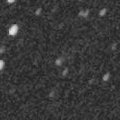
|
Now it is 17.5 mag (Nov. 8, C. Rinner, F. Kugel). It has already passed the perihelion, however, it tends to be brightest after the perihelion passage. In the Northern Hemisphere, it will be observable at 17.5 mag in good condition until the end of 2010. It locates extremely low in the Southern Hemisphere.
Date(TT) R.A. (2000) Decl. Delta r Elong. m1 Best Time(A, h)
Dec. 11 9 24.22 20 45.8 1.688 2.359 121 17.7 2:53 (200, 32)
Dec. 18 9 22.23 19 58.3 1.651 2.395 128 17.8 2:54 (192, 34)
|
|
![]()
 C/2010 FB87 ( WISE-Garradd )
C/2010 FB87 ( WISE-Garradd ) C/2008 FK75 ( Lemmon-Siding Spring )
C/2008 FK75 ( Lemmon-Siding Spring ) 240P/2010 P1 ( NEAT )
240P/2010 P1 ( NEAT ) C/2010 G2 ( Hill )
C/2010 G2 ( Hill ) C/2010 A4 ( Siding Spring )
C/2010 A4 ( Siding Spring ) C/2008 S3 ( Boattini )
C/2008 S3 ( Boattini ) 123P/West-Hartley
123P/West-Hartley C/2009 K3 ( Beshore )
C/2009 K3 ( Beshore ) C/2010 S1 ( LINEAR )
C/2010 S1 ( LINEAR ) 2009 YS6
2009 YS6 203P/2008 R4 ( Korlevic )
203P/2008 R4 ( Korlevic ) 2008 YB3
2008 YB3 C/2005 L3 ( McNaught )
C/2005 L3 ( McNaught ) 31P/Schwassmann-Wachmann 2
31P/Schwassmann-Wachmann 2 241P/2010 P2 ( LINEAR )
241P/2010 P2 ( LINEAR )![]()



























